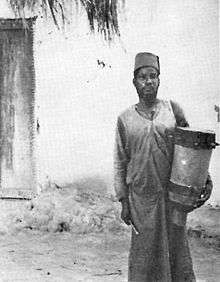Afro-Arab
| Regions with significant populations | |
|---|---|
| Swahili Coast, parts of Arab world | |
| Languages | |
| Arabic | |
| Religion | |
| Islam | |
| Related ethnic groups | |
| Afro-Iranian, Al-Akhdam |
Afro-Arabs are individuals and groups from Africa who are of partial Arab descent. Most Afro-Arabs inhabit the Swahili Coast in the African Great Lakes region, although some can also be found in parts of the Arab world.[1][2]
Overview

By around the 10th century CE, Arabs had established commercial settlements on the Swahili Coast. The Portuguese conquered these trading centers after the discovery of the Cape Road. From the 1700s to the early 1800s, Muslim forces of the Sultanate of Muscat reseized these market towns, especially on the islands of Pemba and Zanzibar. In these territories, the Oman Arabs mingled with the local Negroid populations, thereby establishing Afro-Arab communities.[3] The Niger-Congo Swahili language and culture largely evolved through these intermarriages between Arab men and native Bantu women.[4]
Afro-Arab communities were similarly founded in the Nile Valley, as Arabs intermarried with indigenous Nilotic women.[5] Other Afro-Arabs in the Sudans had little biological connection to Arab peoples, but were instead essentially of Nilotic and Bantu origins, albeit influenced by the old Arabian civilization in language and culture.[6] In the mid-to-late 1800s, Arab traders began to move into the interior, in pursuance of the ivory trade in central Africa.[7] Unlike other cases of racial mixing, Arabs generally did not view Afro-Arabs as half-caste. Afro-Arabs instead enjoyed similar statuses in their societies as long as the father was Arab.[5] Thus, after the Zanzibar Revolution of 1964, many of the Afro-Arabs that left Zanzibar and settled in Oman were able to attain high political and diplomatic positions and be accepted as Arabs.[8] Racial assimilation of Afro-Arabs with non-Arab Africans also aided Muslim missionaries in the spread of Islam throughout Africa.[5]
In the Arab states of the Persian Gulf, descendants of people from the Swahili Coast perform traditional Liwa and Fann At-Tanbura music and dance.[9] The mizmar is also performed by Afro-Arabs in the Tihamah and Hejaz regions of Saudi Arabia.
In addition, Stambali of Tunisia and Gnawa music of Morocco are both ritual music and dances, which in part trace their origins to West African musical styles.
See also
References
- ↑ Romero, Patricia W. (1997). Lamu. Markus Wiener. p. 7. ISBN 1558761063. Retrieved 25 November 2014.
- ↑ Gunnar M Ahmad Abdel Ghaffar Muhammad Chr Michelsens Institutt (2013). Sudan Divided: Continuing Conflict in a Contested State. Palgrave Macmillan. p. 90. ISBN 1137338245. Retrieved 25 November 2014.
- ↑ Hinde 1897, p. 2
- ↑ Tarikh, Volumes 1-2. Longman. 1966. p. 68. Retrieved 6 December 2016.
- 1 2 3 Mazrui 2014, p. 77
- ↑ Guarak 2011, pp. 7 & 401
- ↑ Hinde 1897, p. 3
- ↑ Mazrui & Mutunga 2004, p. 324
- ↑ Poul Rovsing Olsen, "La Musique Africaine dans le Golfe Persique", Journal of the International Folk Music Council, Vol. 19, (1967), pp. 28-36
Notes
- Guarak, Mawut Achiecque Mach (2011). Integration and Fragmentation of the Sudan: An African Renaissance. AuthorHouse. ISBN 9781456723569.
- Hinde, Sidney Langford (1897). The Fall of the Congo Arabs. London: Methuen & Co.
- Mazrui, Alamin M.; Mutunga, Willy, eds. (2004). Debating the African Condition: Race, gender, and culture conflict (illustrated ed.). Africa World Press. ISBN 9781592211456.
- Mazrui, Ali A. (2014). The Politics of Gender and the Culture of Sexuality: Western, Islamic, and African Perspectives. University Press of America. ISBN 9780761864035.
External links
- Arab Slave Trade Afo-Arab relations and the Arab Slave Trade
- "Black Africans in (Arab) West Asia" - a cited ColorQ.org essay
- Prof. Helmi Sharawy, Arab Culture and African Culture: ambiguous relations, paper extracted from the book The Dialogue between the Arab culture and other cultures', Arab League, Educational, Cultural and Scientific Organisation (ALECSO), Tunis, 1999.
- Resolution on Afro-arab Co-operation of The Council of Ministers of the Organization of African Unity, 23, February 23–28, 1987.
- African Union/league of Arab States Inter-secretariat Consultative Meeting On Afro-arab Cooperation, Addis Ababa: 10–12 May 2005.
- Maho M. Sebiane, « Le statut socio-économique de la pratique musicale aux Émirats arabes unis : la tradition du leiwah à Dubai », Chroniques yéménites, 14, 2007..
- Afro-Arabian origins of the Early Yemenites and their Conquest and Settlement of Spain